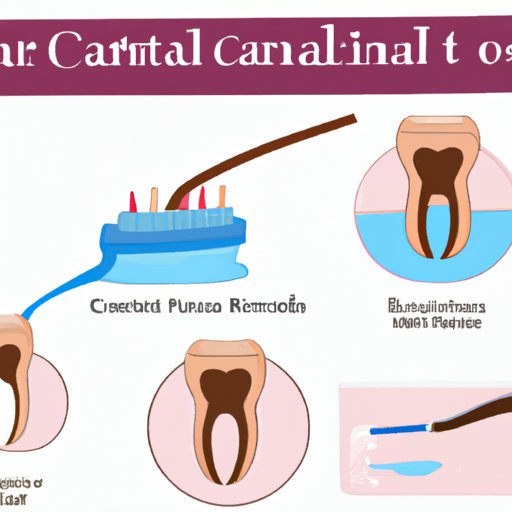
I. Introducing the Root Canal Treatment
Root canal procedure is a dental treatment that aims to eliminate an infection in the tooth’s pulp (the soft tissue inside the tooth). The procedure involves removing the infected tissue, cleaning and disinfecting the root canal, and filling it with a material called gutta-percha. The purpose of this article is to provide comprehensive information about root canal procedures and why you might need one. Whether you are scheduled for a root canal treatment, have recently undergone one, or just want to learn more about it, this article is for you.
II. Dental Pulp Infection: Why You Need a Root Canal
Dental pulp infection or inflammation is the most common reason for needing a root canal procedure. The pulp can get infected due to deep decay, repeated dental procedures on the tooth, a crack or chip in the tooth, or trauma to the face. If left untreated, dental pulp infections can cause a wide range of complications, including intense pain, abscesses, swelling, tooth loss, and even systemic infections. Thus, it is important to recognize the symptoms of dental pulp infections and get prompt treatment.
The symptoms of dental pulp infections include:
- Pain when biting and chewing
- Sensitivity to hot or cold temperatures that lingers even after the stimuli are removed
- Sudden onset of severe pain and throbbing in the tooth
- Swollen gums
- Darkening of the tooth
- Small pimple-like bump on the gums near the affected tooth
These symptoms may indicate a dental pulp infection, and you should seek dental care as soon as possible. Failure to treat a dental pulp infection can lead to the loss of the entire tooth and an increased risk of developing other health problems.
Here are the top five reasons you may need a root canal:
- You have a severely decayed tooth that has infected the pulp.
- Your tooth has been injured due to trauma, causing pulp inflammation or infection.
- You have had multiple dental procedures done on the same tooth, causing weakening of the tooth’s structure and potentially damaging the pulp.
- You have a cracked or fractured tooth that exposes the pulp to bacteria, leading to an infection.
- You are experiencing significant pain caused by an infected pulp.
III. Debunking Misconceptions about Root Canals
Root canal treatments have a reputation for being painful and traumatic, which deters many people from seeking timely dental care and experiencing relief. However, modern root canal procedures are vastly different from those of the past and are typically painless, thanks to advanced anesthetic techniques. Whether you have heard myths from friends or the internet, it’s essential to know the truth about root canals to make informed decisions about your dental health.
Here are some common myths and the realities of root canal procedures:
- Myth: Root canal procedures are painful.
- Reality: Root canal treatments are usually painless. The pain many people associate with root canals is caused by the infection in the tooth, not the procedure itself. With local anesthesia and sedation dentistry, most patients feel little to no pain during a root canal.
- Myth: Root canal treatments cause illness.
- Reality: There is no scientific evidence that root canal procedures cause illness or systemic infections. In fact, root canal treatments can prevent further illness by removing bacterial infections and saving the natural tooth.
- Myth: Tooth extraction is better than root canal treatment.
- Reality: Preserving the natural tooth is always the best option whenever possible. Tooth extraction can cause a host of complications such as bone loss, speech problems, and difficulty eating or speaking.
- Myth: Root canal-treated teeth eventually need to be extracted.
- Reality: Root canal-treated teeth can last a lifetime with proper dental care, such as regular brushing, flossing, and dental checkups.
It’s crucial to seek credible and accurate information about root canals from trustworthy sources such as dental professionals.
IV. Pain Management in Root Canal Treatment
While root canal procedures are not usually painful, it’s common to feel sore or sensitive after the treatment. Your dentist will provide guidance on ways to manage pain and reduce inflammation before, during, and after the procedure. These options may include:
- Nonsteroidal anti-inflammatory drugs (NSAIDs) such as ibuprofen or aspirin for pain relief
- Local anesthesia to numb the affected area during the procedure
- Sedation dentistry, including oral sedatives or nitrous oxide, to help you relax during the procedure
Your dentist will provide detailed instructions on pain management and how to care for your tooth after the procedure, such as avoiding crunchy or sticky foods and maintaining good oral hygiene.
V. Weighing the Pros and Cons of Root Canals
Like any medical or dental procedure, root canal treatments have benefits and drawbacks. Understanding the pros and cons of root canals can help you make an informed decision about your dental health.
Here are some of the benefits of root canal procedures:
- Pain relief: Root canal treatment can provide immediate and long-lasting relief from the pain caused by dental pulp infections.
- Preservation of natural teeth: Instead of extracting the infected tooth, root canals aim to preserve healthy tooth structure, allowing you to keep your natural teeth.
- Improved oral health: Root canal treatments can prevent further infection and reduce the risk of other dental problems such as gum disease and tooth decay.
- Aesthetically pleasing: Root canals create a natural look that is virtually indistinguishable from the surrounding teeth,
- A root canal treatment prevents any further damage from the infected tooth.
Here are some disadvantages of the procedure:
- Multiple visits: In some cases, root canal treatments require more than one visit to complete.
- Sensitivity after the treatment: Sensitivity may occur for a few days after receiving a root canal treatment
VI. The Importance of Root Canal Treatment in Preserving the Tooth and Preventing Further Complications
Not treating dental pulp infections can lead to various complications, such as pus-filled abscesses, bone loss around the affected tooth, and systemic infections that could lead to hospitalization or even death. Root canal treatments are critical in preserving the tooth and preventing further complications.
Identifying complications that could arise from not treating dental pulp infections could help you avoid more extensive dental problems. These complications may include:
- Severe pain
- Spread of infection to other teeth and gums
- Bone loss and degeneration
- Formation of pus-filled abscesses
- Dental cysts and tumors
- Systemic infections
Preventive measures such as practicing good oral hygiene, wearing a mouthguard when involved in contact sports, and regularly seeing a dentist can significantly reduce the risk of dental pulp infections and the need for root canal procedures.

VII. Alternatives to Root Canal Treatment
There are other dental treatments available that can replace root canal treatments. Extraction and dental implants are common alternatives to root canal treatment.
Extraction is the removal of the infected tooth, which can prevent further damage to the surrounding teeth and gums. Unfortunately, extraction can affect adjacent teeth, causing crooked and misaligned teeth. Another setback is that extraction could lead to the formation of bone defects, affecting the gum’s appearance.
Dental implants replace the entire tooth, including the root, with a prosthetic that is anchored to the jawbone. This option would be ideal if the tooth is damaged beyond repair or it is necessary to replace the infected tooth. However, implants are more expensive than root canal treatments and traditionally require multiple dental visits.
When deciding between a root canal procedure or an alternative, it is crucial to discuss with your dentist in-depth regarding the treatment that best fits your needs and situation.
VIII. Conclusion
Root canal procedures have changed significantly in recent decades, and the treatment is now efficient, painless, and an essential tool in dental health. Timely treatment of dental pulp infections can help preserve the natural tooth, relieve pain and prevent systemic infections. Remember to speak to your dental professional if you have any questions or concerns about root canal treatment or any dental procedure.
Ultimately, your dental professional plays a vital role in diagnosing, treating and helping you maintain healthy teeth. We hope you’ve found the information in this article helpful in understanding why you may need a root canal, how to prepare for the procedure, and the different treatment alternatives available.





